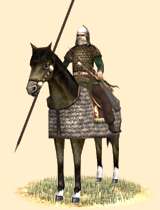Rauxsa-alanna Uaezdaettae (Roxolani Noble Cavalry)
 |
Weapons | Defence | Mental | ||||||
|---|---|---|---|---|---|---|---|---|---|
| Primary | Secondary | Armour: | 12 | Morale: | 16 | ||||
| Type: | none | spear | Shield: | 0 | Discipline: | disciplined | |||
| Attack: | 6 | 5 | Skill: | 12 | Training: | highly_trained | |||
| Charge: | 44 | 44 | Recruitment | Other | |||||
| Lethality: | 1 | 0.4 | Soldiers: | 25 | Hit Points: | 1 | |||
| Range: | 190.4 | 0 | Cost: | 3623 | Mass: | 1 | |||
| Ammo: | 40 | 0 | Upkeep: | 906 | |||||
| Turns: | 1 | ||||||||

These noble horsemen are well armoured as are their mounts. Armed with spear and bow they can be turned to any task and should not be committed lightly.
Superior
Disciplined
Very Hardy
Can Form Cantabrian Circle
If many Roxolani riders can now equip themselves with corselets of scale armor, their nobility will take this trend one step further and provide defenses for the horses they ride as well. Protecting their mounts represents a substantial advantage for horsemen expected to charge headlong into the enemy, as horses, being a large target, are particularly vulnerable to missiles. In addition, when both horse and rider are armored, their momentum increases and their potential impact is greater. Thus, the charge of a group of Roxolani nobles is truly terrible and will often succeed in punching a hole in an enemy battle line that the rest of the warriors will be able to exploit. This does not mean that they constitute any of sort of “forlorn hope” or are particularly suicidal. Typically, they will first probe for weaknesses and, if none are readily found, they will work to create them. For such a task they may well resort to their bows, using archery to “soften” a spot prior to a charge. For an astute commander, they are a very valuable resource which should not be lightly squandered
Historically, only the richest Sarmatian chieftains were able to furnish complete sets of defensive equipment for both themselves and their horses. However, the impact, at least psychological, of such superbly equipped riders upon their enemies seems to have been much greater than what their numbers alone might have led to expect. Often, depictions of Sarmatians in battle produced by their enemies show masses of armoured horsemen. Archaeology and other sources indicate that this is a major overstatement, but such representations still probably hint about what most durably impressed the foes of the Sarmatians.